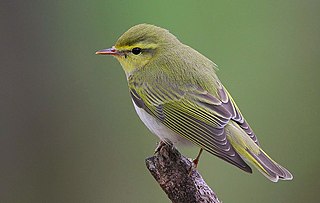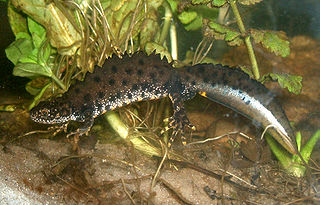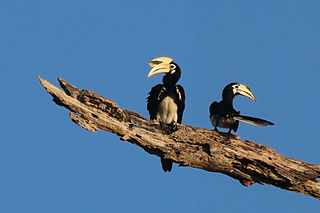
The wood warbler is a common and widespread leaf warbler which breeds throughout northern and temperate Europe, and just into the extreme west of Asian Russia in the southern Ural Mountains.

The piping plover is a small sand-colored, sparrow-sized shorebird that nests and feeds along coastal sand and gravel beaches in North America. The adult has yellow-orange-red legs, a black band across the forehead from eye to eye, and a black stripe running along the breast line. This chest band is usually thicker in males during the breeding season, and it is the only reliable way to tell the sexes apart. The bird is difficult to see when it is standing still, as it blends well with open, sandy beach habitats. It typically runs in short, quick spurts and then stops.

The eastern towhee is a large New World sparrow. The taxonomy of the towhees has been under debate in recent decades, and formerly this bird and the spotted towhee were considered a single species, the rufous-sided towhee.

The willow flycatcher is a small insect-eating, neotropical migrant bird of the tyrant flycatcher family native to North America.

The spotted owl is a species of true owl. It is a resident species of old-growth forests in western North America, where it nests in tree hollows, old bird of prey nests, or rock crevices. Nests can be between 12 and 60 metres high and usually contain two eggs. It is a nocturnal owl which feeds on small mammals and birds. Three subspecies are recognized, ranging in distribution from British Columbia to Mexico. The spotted owl is under pressure from habitat destruction throughout its range, and is currently classified as a near-threatened species.

The northern crested newt, great crested newt or warty newt is a newt species native to Great Britain, northern and central continental Europe and parts of Western Siberia. It is a large newt, with females growing up to 16 cm (6.3 in) long. Its back and sides are dark brown, while the belly is yellow to orange with dark blotches. Males develop a conspicuous jagged crest on their back and tail during the breeding season.

Mycetophilidae is a family of small flies, forming the bulk of those species known as fungus gnats. About 3000 described species are placed in 150 genera, but the true number of species is undoubtedly much higher. They are generally found in the damp habitats favoured by their host fungi and sometimes form dense swarms.

Bachman's sparrow, also known as the pinewoods sparrow or oakwoods sparrow, is a small American sparrow that is endemic to the southeastern United States. This species was named in honor of Reverend John Bachman.

Livingstone's fruit bat, also called the Comoro flying fox, is a megabat in the genus Pteropus. It is an Old World fruit bat found only in the Anjouan and Mohéli islands in the Union of the Comoros in the western Indian Ocean.

The oriental pied hornbill is an Indo-Malayan pied hornbill, a large canopy-dwelling bird belonging to the family Bucerotidae. Two other common names for this species are Sunda pied hornbill (convexus) and Malaysian pied hornbill.

Boletina is a settlement to the east of Ponikva in the Municipality of Šentjur, in eastern Slovenia. The settlement, and the entire municipality, are included in the Savinja Statistical Region, which is in the Slovenian portion of the historical Duchy of Styria. Close to the settlement is one of the rare habitats where the pasque flower grows in Slovenia.

Acnemia nitidicollis is a Palearctic species of 'fungus gnat' in the family Mycetophilidae. The larvae of Acnemia are mycetophagous in rotting wood.

Boletina griphoides is a Palearctic species of 'fungus gnat' in the family Mycetophilidae. The larvae of B. griphoides are thought to be mycetophagous in the ground litter. Adults sometimes appear in enormous numbers in spring in a wide variety of habitats.

Diadocidia ferruginosa is a Palearctic species of fungus gnat in the family Mycetophilidae. They live as larvae in long dry silken tubes under bark or in rotten wood and probably feed on fungal mycelia or spores. Also associated with Peniophora.

Boletina gripha is a Palearctic species of 'fungus gnats' in the family Mycetophilidae. It is found in a wide variety of habitats from wooded streams to wetlands and open moorland. Reared from brown rot of spruce stump, spruce log bearing loose bark and decaying wood of pine. Larvae have been on the surface of decaying wood covered with Resinicium bicolor, from soil in pine forest and from fruiting bodies of Suillus bovinus.

Boletina trivittata is a Palearctic species of fungus gnat in the family Mycetophilidae. Members of this genus live in a wide range of habitats, from wooded streams to wetlands to open moors. Adults have been insect trapped on a variety of substrates, including rotting wood and soil litter.
Sciophilinae is a subfamily of fungus gnats. There are at least 40 genera and 340 described species in Sciophilinae.

Boletina is a genus of fungus gnats in the family Mycetophilidae. There are at least 30 described species in Boletina.
Gnoristinae is a subfamily of fungus gnats in the family Mycetophilidae. There are about 6 genera and at least 4 described species in Gnoristinae.

Mycetophilinae is a subfamily of fungus gnats in the family Mycetophilidae. There are more than 30 genera and 2,000 described species in Mycetophilinae. There are two tribes, Exechiini and Mycetophilini.




















